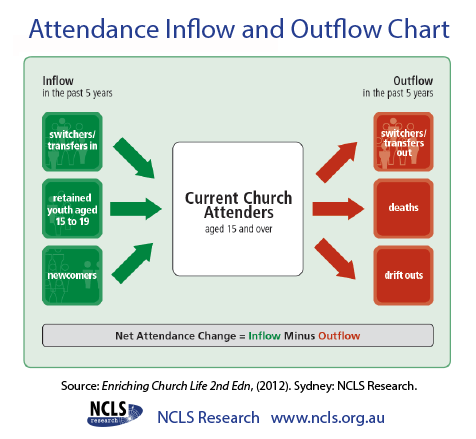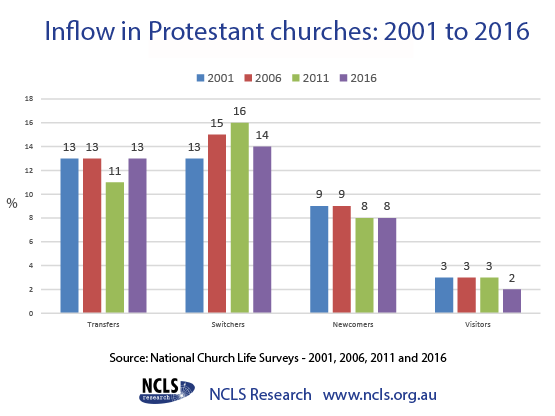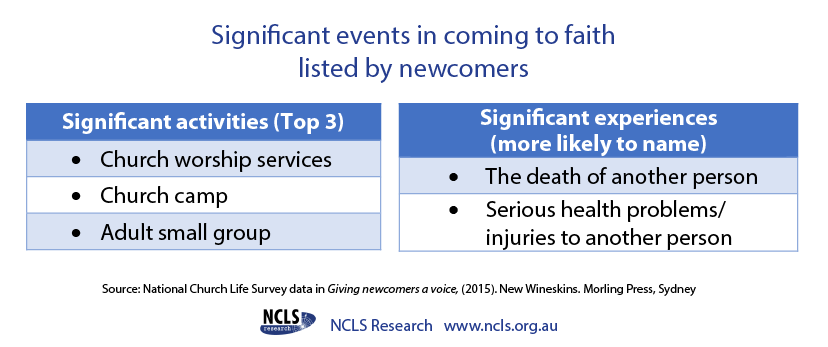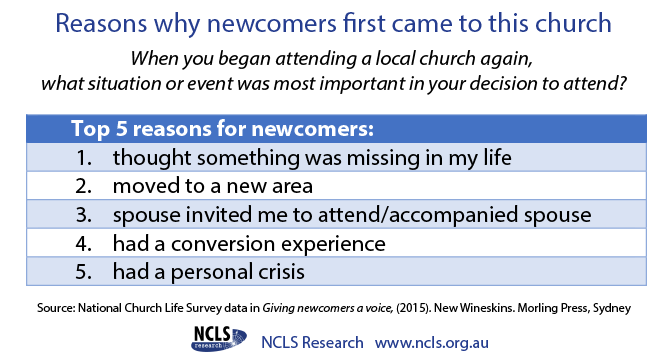The flow of newcomers is an important measure of how well a local church is connecting with the wider community.
The inflow of newcomers into Protestant churches has remained constant over time (8% to 9%). Protestant newcomers are more like the “average Australian” than other church attenders.
Things we know about newcomers is that they don't 'church shop'; they come to faith in a gradual process; and they usually come to church out of a sense that something is missing in their life. In times of COVID restrictions and isolation, churches can still be aware of newcomers seeking a community of faith to connect with.
Inflow of new people into a church
The flow of newcomers is an important measure of how well a local church is connecting with the wider community.
"Newcomers" are defined as attenders who are new to their current church and who were not attending any church five years ago.
Attendance inflow into a church can be seen in a number of ways, by new people arriving either by switching churches from another denominations (switchers), transferring from another church in the same denomination (transfers), teenagers and young people becoming adult attenders (young adult retention); and new people who in recent years haven't attended any church (newcomers). There are various 'outflows' where people leave the church for a number of reasons.
The net attendance level is measured by inflow minus outflow. Where the inflow is greater than the outflow, a church is growing numerically.

Church vitality includes inflow of newcomers
The inflow of newcomers is a sign of health and vitality. The level of newcomers into Protestant churches has not changed over time (around 8% to 9% for the 25 year period between 2001 and 2016). The highest proportion of movement of new people into churches, is in fact in the “switchers” category.

Protestant Newcomers are more like the “average Australian”
Research findings show that newcomers are most likely to seek out a church in early-to-mid adulthood (20 to 40 years of age).
The typical newcomer is more likely to be younger (mean age 38), be a first or second generation migrant, and less likely than to be university educated.
Newcomers are more likely than other regular attenders to have come to faith through a gradual process and not the “wide eyed convert”.
Mothers are most likely to be named as one of “the most significant people to show me what faith was about”.
The next most significant influencing factors for newcomers are “ministers” followed by “fathers”. The lowest recorded defined group to show newcomers what faith was about were television/radio evangelists.
Coming to faith: significant events
Church worship services are the most significant event that newcomers recall in helping them come to faith. The top three significant activities are church worship services, church camp, adult small group. Significant experiences that bring newcomers to church are the death of another person; and serious health problems/injuries to another person.

Shopping around
In the preceding 12 months before starting at their current church, two thirds of newcomers surveyed did not visit or attend any other church. This suggests newcomers tend not go “church shopping”.
Why did you go to a church?
What triggers first church attendance? We asked people when they began attending a local church again, “what situation or event was most important in your decision to attend?”
The top five reasons for newcomers are: thought something was missing in my life (29%), moved to a new area (10%), spouse invited me to attend/accompanied spouse (8%), had a conversion experience (8%), had a personal crisis (8%). What helped them stay? The people come first. This is the most important thing, that they knew people there. Other influences were they were invited to attend, the church was convenient, the perceived quality of preaching/teaching, the character or style of leader, and it was the local church of their denomination.

Religious belief, practices and experiences
While newcomers are less likely to assent to some Christian beliefs, their views and experience of God are no different to other attenders. Moreover, they are most likely to have grown in their faith in the previous year.
Becoming involved in local church life
Newcomers are less likely to be involved in formal church outreach and service activities or have ministry roles, but they are most likely to be inviting others to church or informally helping others. Newcomers are very positive about their local church leaders and are most confident about the church’s capacity for innovation and achieving future goals.
With the dramatic changes to church and community life brought on by the COVID-19 pandemic, there is some suggestion that people may turn to faith in these times. Anecdotal reports from churches show that new people are attending online courses and groups held virtually, rather than in person. So as people around the country feel the impacts of COVID-19 restrictions and isolation, churches can still be aware of newcomers who may be seeking a community of faith to connect with.
Kathy Jacka and Ruth Powell, NCLS Research with Rod Bennett, WildHive Studios.



